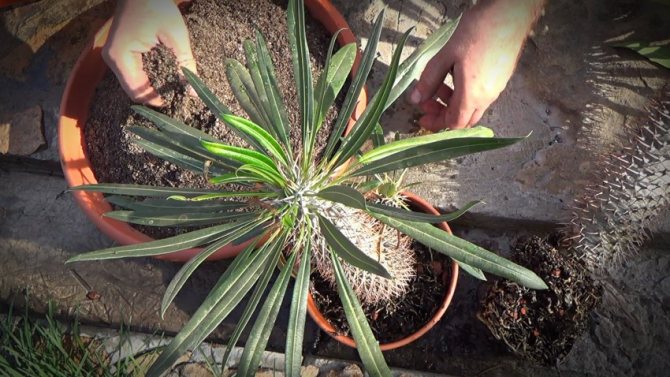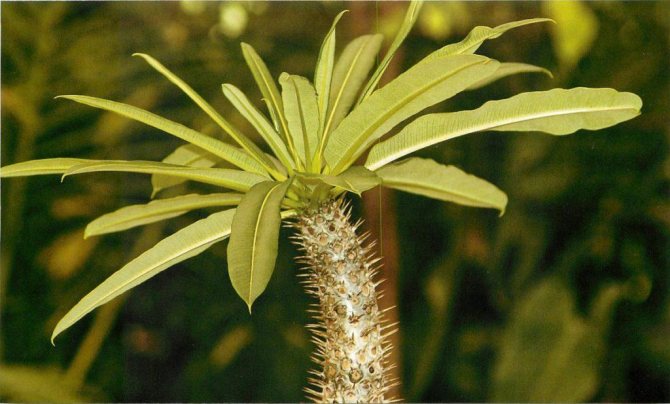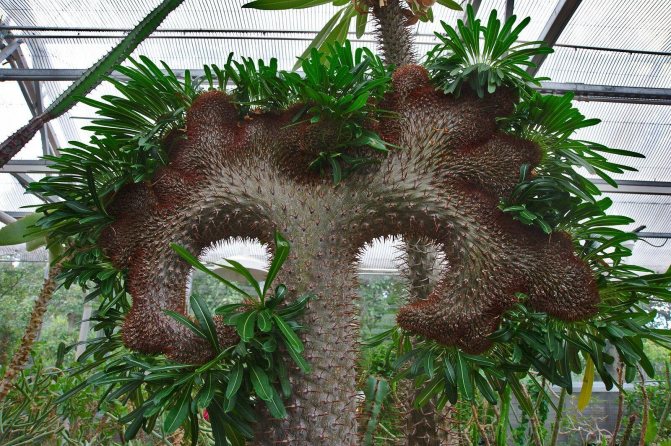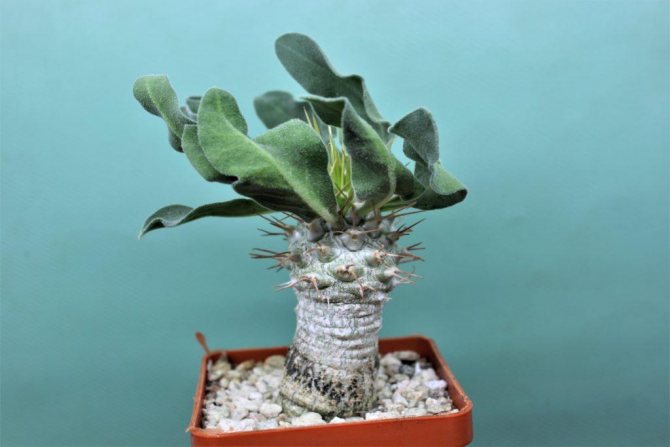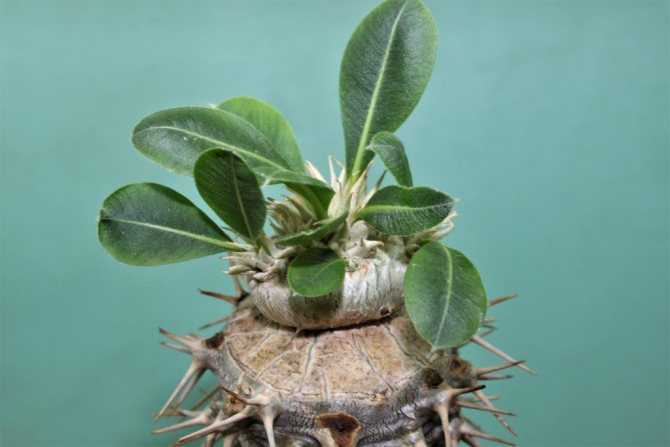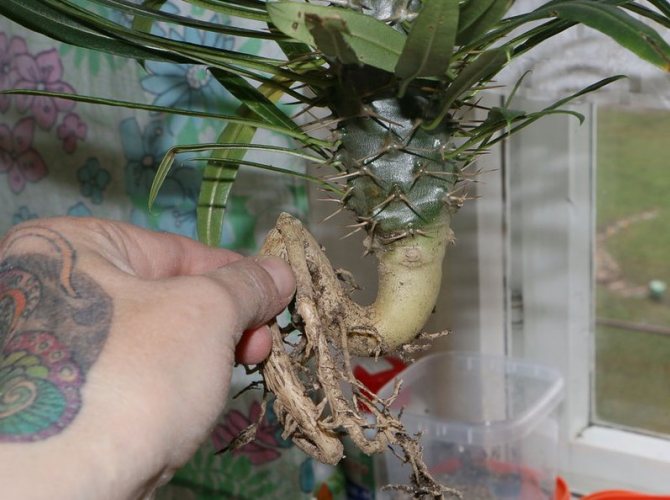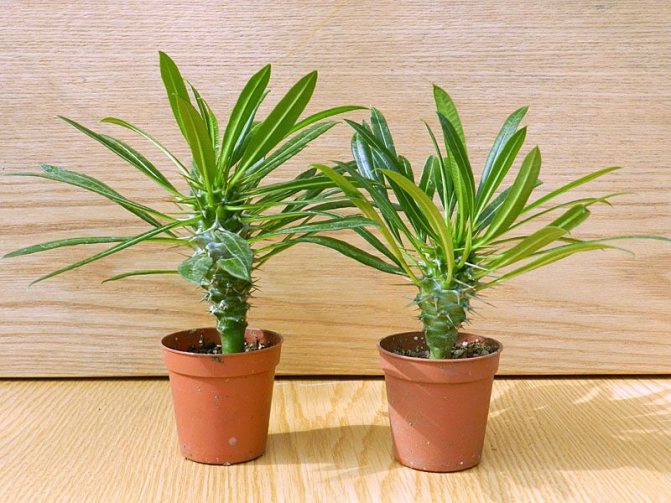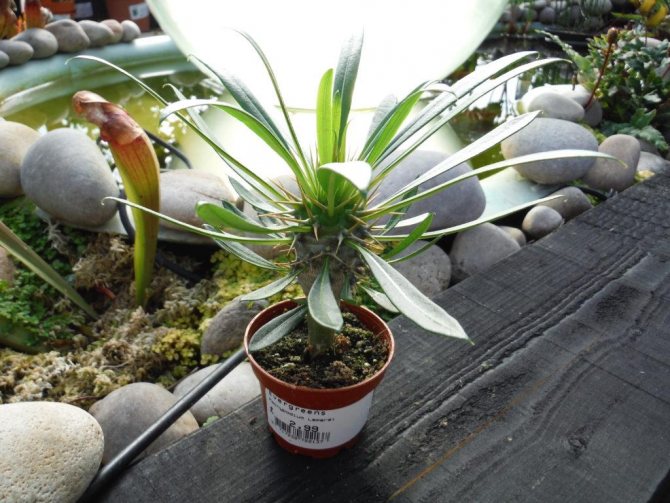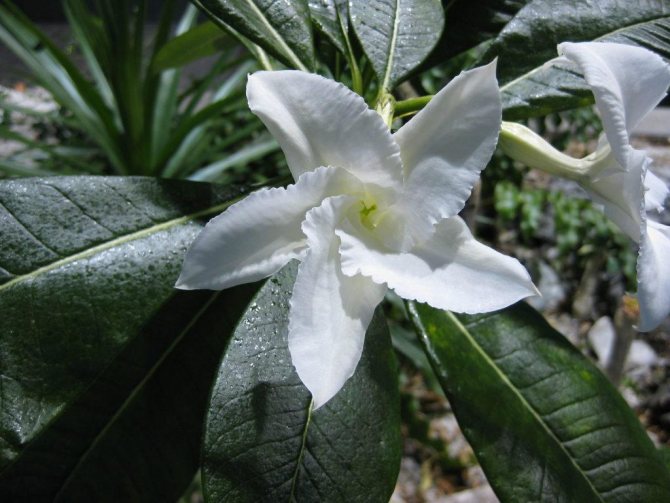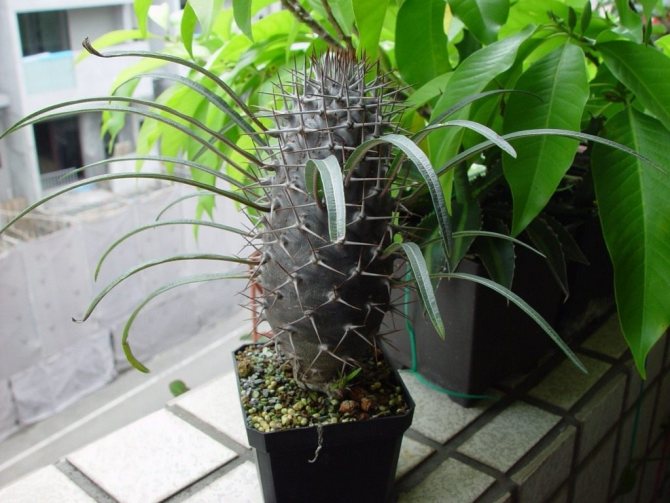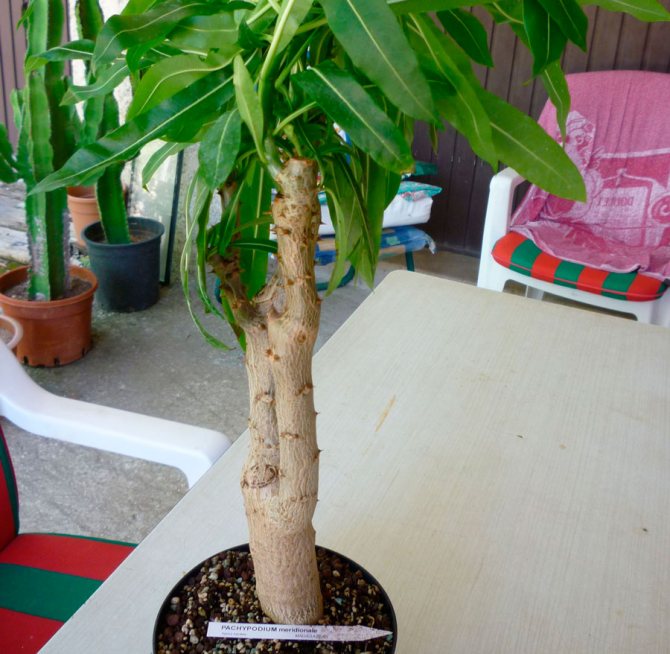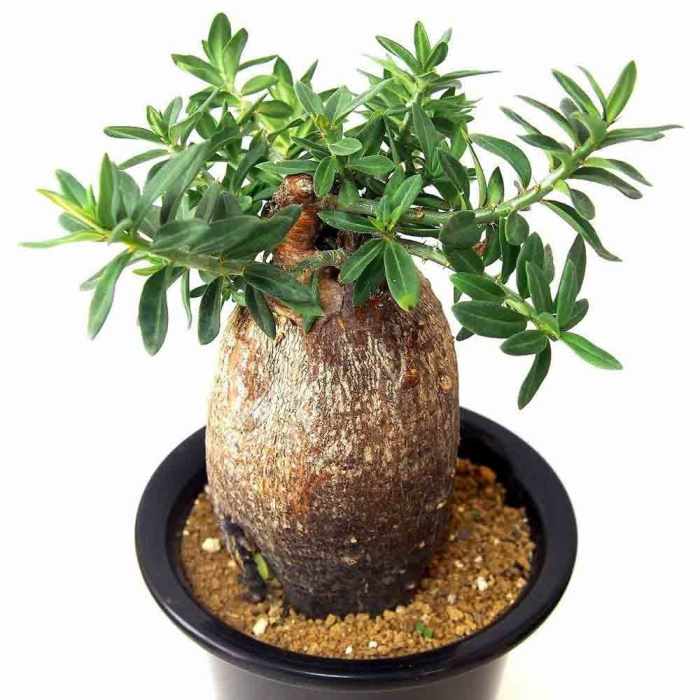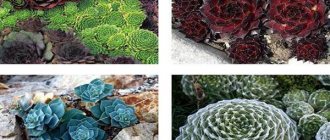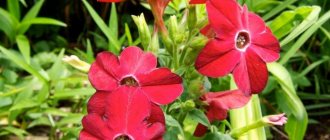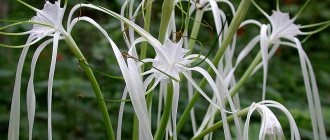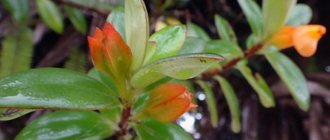
The indoor flower Pachypodium (Latin Pachypodium) is a very unusual plant. Translated from Greek, its name sounds like a thick leg or thick-legged. Indeed, this flower has a fairly thick stem, and only on the crown are thin leaves. In appearance, it resembles a palm tree, only with thorns. In this article, we will introduce you to the different types of Pachypodiums, their places of distribution, growth characteristics and proper care for this exotic flower at home.
Content
- Description
- Pachypodium care Cultivation
- Watering
- Fertilizing pachypodium
- Pachypodium transplant
- Bloom
- Virulence
- Diseases and their treatment
- Pachypodium Lamera (Madagascar palm)
General information about the pachypodium family
These plants are quite large, often up to 7, or even 8 meters in height with a trunk of about one and a half meters. But the bulk of the species is much smaller, and sometimes even dwarf. The latter, from a distance, are difficult to notice - they look like a pile of silver stones or a dried up small cactus.
The ability to withstand an arid climate for a long time is due to the accumulation of a large amount of moisture in a large stem of a plant during the rainy season. The pachypodium is very unpretentious and can survive in extreme conditions, but if you want it to look 100% watering is still necessary. Without it, the plant seems to freeze - growth stops, and the leaves turn pale and fall off. And about flowering, in this situation, there is no need to talk at all. An excess of moisture also negatively affects the aesthetic properties of the plant. Its trunk is thinning and stretching ugly.
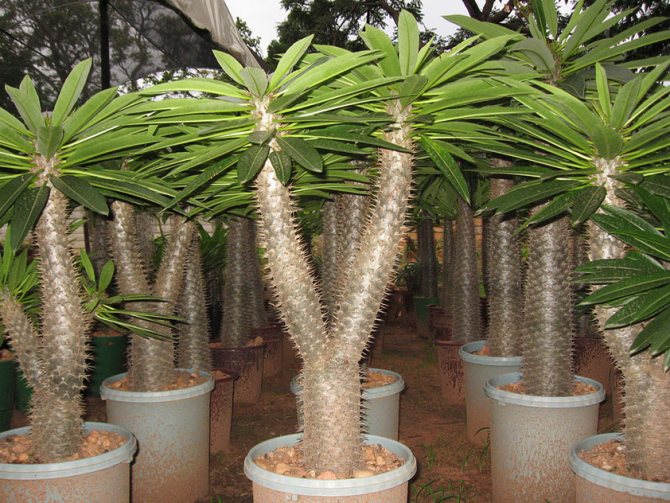

Pachypodium lamera.
At home, as in nature, the pachypodium, like a cactus, grows very slowly - no more than 5 centimeters per year, and when planted in a flowerpot or pot, it can grow up to one and a half meters. The plant reaches maturity at about 6 years old, and it gives the first flower. The lifespan is highly dependent on the quality of care. As a rule, having organized the pachypodium plant care at home, you can observe its vital activity for at least 3 and no more than 15 years.
It is worth paying special attention to the fact that Lamer's pachypodium is very poisonous. If the stem is damaged, a milky liquid is released, which contains a large amount of toxins, so it is quite dangerous for allergy sufferers.
Planting and caring for the pachypodium
- Bloom: in the spring, for the first time - in the sixth or seventh year of life.
- Lighting: bright diffused light.
- Temperature: in summer - from 20 to 30 ºC, in winter - 16-18 ºC. Protect the plant from drafts!
- Watering: in spring and summer - moderate, when the substrate dries out to a depth of 1 cm, in winter - sparse and scarce. After dropping the leaves, watering is stopped. The short-stemmed species requires poor watering throughout the year.
- Air humidity: usual.
- Top dressing: from early spring to mid-autumn, once a month with fertilizers for cacti.
- Rest period: from approximately November to March.
- Transfer: young plants - every spring, adults - once every 3-4 years.
- Reproduction: seeds, less often cuttings.
- Diseases: fungal rot.
- Pests: spider mites, thrips.
- Properties: the plant has poisonous juice!
Read more about growing pachypodiums below.
Boarding and transferring after purchase
Young pachypodiums transplanted annually in the spring, and adults - every 2-3 years... Delicate roots and slow growth are the reasons for a rare and very neat transplant. It is advisable to transplant the newly acquired plant - the transport soil mixture is sometimes completely peaty, which means that there is a risk of waterlogging. In addition, soil change will protect the "Madagascar palm" - if there were pests in the ground, they will be neutralized. In addition, you should carefully examine it or even wash the leaves with laundry soap and rinse under a warm shower.
Priming
The best transplant substrate is obtained if you mix equal quantities of leafy and sod land with perlite or coarse sand. Another option:
- 1 part turf land
- 1 part ready-to-use cactus mixture
- 0.5 parts of peat
- 1 part perlite or coarse sand
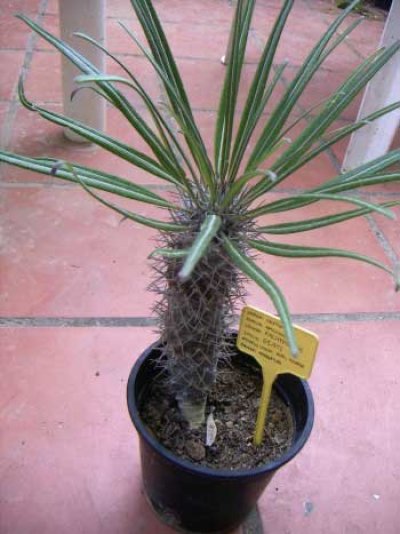

The most important condition - drainage should occupy from one third to half the volume of the pot. It is helpful to add pieces of clay, charcoal, or brick to the substrate. The holes in the bottom of the container must be large! You can also grow the palm using hydroponics.
Fertilizer / feeding
In the spring and summer period, feeding the pachypodium will not hurt every two weeks fertilizer for succulents. In the first month or two after transplanting, he is not fertilized - the additives included in the soil are enough for him.
Watering and humidity
The fleshy trunk of the pachypodium is excellent stores moisture - this makes him not afraid of drought and dry air. However, there is one trick - the perfect balance between moderate watering and drought gives the green pet its best shape. If you dry out a succulent, it will lose its foliage, and if it is waterlogged, the trunk will stretch excessively.
The optimal irrigation regime is plentiful from March to October, but without waterlogging, and moderate in the rest of the months. It means that in the warm season, watered every 1-3 days, but in winter - 1-2 times a week or month (as the top layer of the substrate dries up).
Spraying the "Madagascar palm" is possible, but not necessary. She will like the regular wiping the leaves damp cloth. Water is required warm and settled.
Pachypodium plant - description
Pachypodiums are succulent shrubs or trees, the characteristic feature of which, despite the many differences between species and varieties, is a thick trunk that retains a supply of water in case of drought. Otherwise, the appearance of the pachypodium species is diverse and ranges from bottle-shaped dwarfs to cactus-like trees. Almost all pachypodium species have spines, which are grouped in threes or pairs and are arranged in spirals or rings around the trunk. Branching is also characteristic of plants of this genus, however, there are species among the pachypodiums that do not form branches. Unlike other representatives of the Kutrovy family, the juice of the pachypodiums is not milky, but transparent, although just as poisonous.
In indoor culture, the pachypodium plant grows from 30 to 150 cm, and its life span is from 3 to 15 years.
Wildlife conditions
The pachypodium or Madagascar palm in the wild is a succulent tree or shrub. Belongs to the kutrov family. There are twenty species in total, the smallest are the size of a palm, and the largest reach the height of a three-story building.
The thorns are their prickly feature, grouped in bunches, arranged in rings along the trunk. The thorns grow simultaneously with the leaf plate, then their growth slows down, they harden, turning into needles sticking out in different directions. Pachypodiums are:
- dwarf up to 8 cm in height, up to 40 cm in trunk diameter or an oval bush up to 4 m in height;
- branching / non-branching cigarette-like;
- trees of the form of giant cacti up to 5 m tall.
Pachypodium care at home
Growing pachypodium at home
The pachypodium needs a lot of light and is not afraid of the sun's rays. In the summer, he will feel great on the balcony or in the garden, but he needs to be accustomed to the open air. In the room, it is better to keep the flower on the southern, southwestern or southeastern windowsill. When spring comes after short winter days, the pachypodium should also be gradually taught to the effects of direct sunlight.
- Golden mustache: properties and contraindications, planting and care


The pachypodium loves fresh air, but does not tolerate drafts. The temperature in summer does not play a special role for the plant: the pachypodium grows well and develops at both 20 and 30 ˚C. In winter, the plant needs a cool content: the pachypodium spends its rest period at 16-18 ˚C.
Watering the pachypodium
Caring for your home pachypodium is easy. In spring and summer, watering it should be moderate so that the soil in the pot is slightly moist all the time. If the plant lacks water, it will shed its leaves and lose its attractiveness, and if there is a lot of moisture, the pachypodium at home will begin to painfully stretch out, which will also not add decorative effect to it. Water the plant when the potted soil dries out to a depth of 1 cm. For the short-stemmed pachypodium, poor watering is sufficient throughout the year. If the plant has dropped its leaves, stop watering altogether and the leaves will grow back in 5-6 weeks.
About growing milkweed - a lot of species and varieties
The plant does not need high air humidity, but it will graciously take your care if you wipe its leaves with a damp sponge from time to time and spray it with settled water at room temperature from a spray bottle. By the way, water for irrigation must also be defended.
Fertilizing pachypodium
The pachypodium plant is fertilized from early spring, when new shoots begin to grow, until mid-autumn. Top dressing in the form of a fertilizer solution for cacti is applied on a pre-moistened soil once a month.
You cannot fertilize the pachypodium for a month after transplanting and when it is sick.
Before entering the dormant period, feeding is stopped and resumed only next spring.
- Golden mustache: properties and contraindications, planting and care
Pachypodium transplant
Young pachypodiums need to be transplanted into a larger pot every spring, and adults once every three or even four years. Moderately acidic soil for cacti is optimal for plants. If it was not found in the store, you can make a substrate from equal parts of river coarse sand, turf and leafy soil. To improve drainage qualities, brick chips or charcoal should be added to the substrate. However, this does not exclude the need to place a layer of expanded clay into the pot when transplanting, filling the container by a third of the volume.
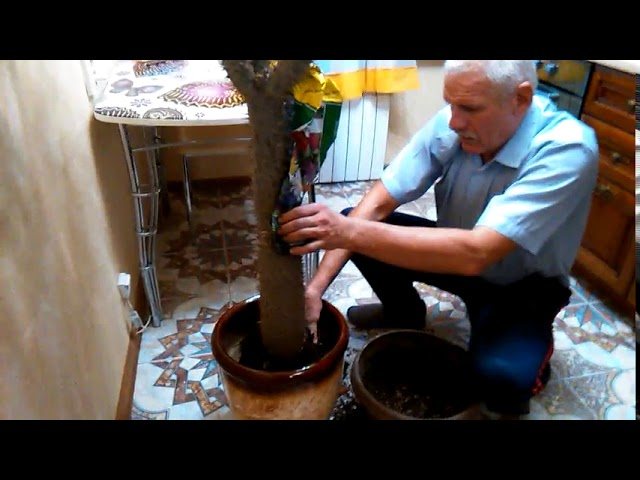

When replanting an indoor pachypodium, try to be careful not to damage the plant's root system. If the succulent is healthy, simply transfer it from the old pot to a new one and fill the remaining space with potting soil. Free the plant with diseased roots from the old soil, remove rotten or dried out areas, treat the wounds with charcoal powder, and only then complete the transplant.
Flowering pachypodium
The indoor pachypodium flower grows very slowly, so you have to wait six or seven years for its first flowering, but if the plant is poorly or improperly looked after, it may not bloom at all. Follow the rules for caring for a succulent, do not allow drafts in the room, make sure that the plant has enough food and light, and then one day you will be lucky to see pachypodium flowers.
Toxicity of the pachypodium
The pachypodium secretes a poisonous sap, which irritates the mucous membranes and corrodes wounds on the skin, so it must be washed off immediately with plenty of water.


In the photo: How the pachypodium blooms in the apartment
Transfer
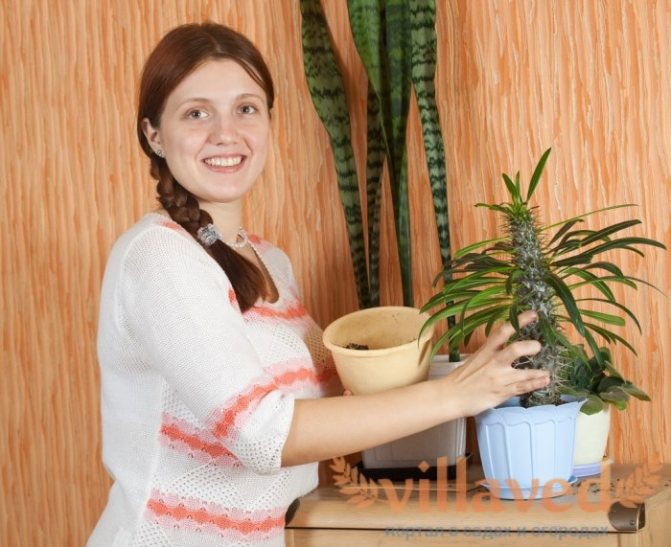

Pachypodiums usually grow very slowly, the growth is about 5 cm per year. Therefore, they do not need frequent transplants. A young bush can be transplanted a year after planting in a slightly larger pot, and after that two or three years will pass when he may need the next transplant. Perform it before the onset of cold weather or early spring.
It might be interesting: Hoya - home care tips
It is better to buy soil for a flower in a special store, suitable for cacti and succulents. If you decide to prepare the soil yourself, then you will need humus, sand, leaf and turf soil. It is advisable to add pieces of charcoal and brick chips to all substrates. All components must be disinfected (spilled with boiling water or manganese). At the bottom of the pot, at a third of its height, lay a layer of clean expanded clay or other drainage material (small pebbles, aquarium soil, pebbles).
What to do with thorns?
It is not so easy to transplant the Pachypodium, because its trunk is sometimes completely covered with sharp thorns. Thick gloves won't help either. In nature, succulents need thorns both as protection from insects and herbivores, and as water reservoirs. Any atmospheric moisture, be it fog or fallen dew, is absorbed by the thorns, replenishing the moisture reserves in the fleshy stems of the plant. In indoor conditions, this is not so important. If you want to protect yourself from injury when caring for a thorny flower, trim sharp thorns with clean scissors, make them blunt and safer.
After that, putting on tight gloves on your hands, you can take out the flower from the old pot and, together with a lump of earth, gently move it into a new pot prepared for transplanting. Please note that the roots of the Pachypodiums are very delicate and can easily break. Therefore, try to handle them with care during the transplant. Sometimes the soil surface is covered with gravel or decorative stones.
Reproduction of the pachypodium
The pachypodium is propagated by seeds, which you will have to buy, because it is difficult to get them yourself at home. Sowing is carried out to a depth of half a centimeter, the container is covered with glass or film and kept in a bright place at a temperature of 20 ˚C. When seedlings appear, the cover is removed, but not suddenly, giving the seedlings the opportunity to gradually adapt to the conditions of the room. Fortified seedlings are planted in separate pots and looked after as if they were adult plants. However, it should be remembered that the pachypodium grows from seed very slowly.
How to plant and care for adenium
Reproduction of the pachypodium by cuttings rarely gives results, since parts of its stem do not form roots well, but there have been cases of successful rooting of the top of the plant, in which the base has rotted. It was only necessary to cut the pachypodium at a height of 15 cm with a sharp sterile instrument, process the cut with charcoal powder, plant the top in a substrate for an adult plant and place it in a well-lit place.
How to propagate a pachypodium?
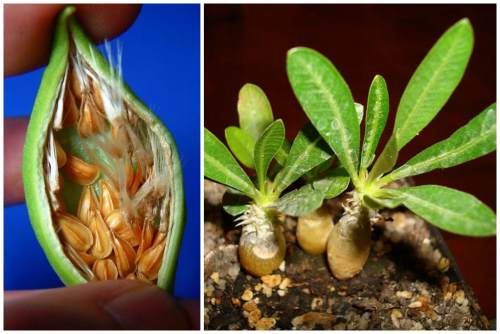

- In the natural habitat, there is only one type of reproduction - seed. Reproduction by seeds is the easiest way of reproduction and in a closed room. Before sowing, the seeds should be soaked for 12-24 hours. Then they are buried in well-moistened sand. The time of emergence of the first shoots from seeds depends on the type of plant.
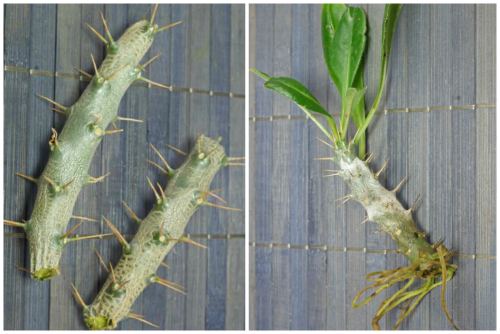

- P. Bispinosum, P. Lamerei, P. Succulentum can be propagated by cuttings, branches and tops. The sole of the segment is dusted with an agent that stimulates the growth of roots and left to dry for 5 days. As soon as the cut is dry, the cutting is buried in a peat pot.
- Grafting is considered the most difficult method available only to experienced breeders. At the same time, only Pachypodium lamerei can act as a rootstock.
Pests and diseases of the pachypodium
Pachypodium diseases and their treatment
The pachypodium at home is very sensitive to excess moisture, therefore it is prone to various rot. So that the plant does not get sick with fungal diseases, its watering must be balanced. Keep in mind that this succulent is easier to tolerate a lack of moisture than excessive moisture, from which its stem becomes thinner and rots, leaves turn black and fall off.
- Golden mustache: properties and contraindications, planting and care
If the flower shows signs of decay, immediately stop watering, place the plant in a warm place, treat it and the substrate in which the pachypodium grows with a fungicide solution and review the watering regime so that no relapses occur in the future.
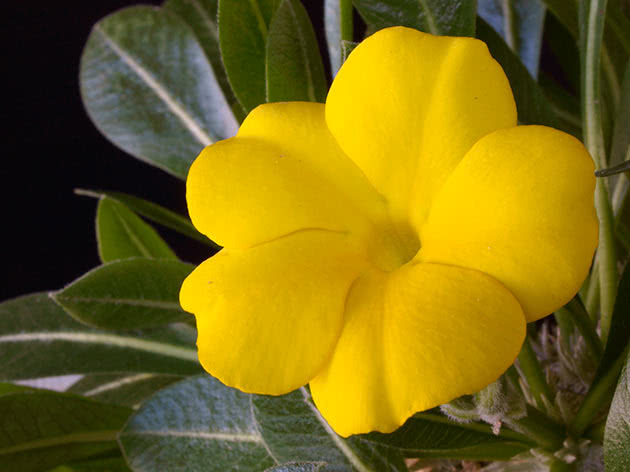

In the photo: Flowering pachypodium at home
Pachypodium pests and control
In a room with dry air, the pachypodium can be infected by spider mites, which suck out cell sap from plants. Due to their small size, it is difficult to notice these pests, but if you find a thin cobweb on the plant, immediately start fighting the ticks: wash the flower under a warm shower and try to slightly increase the humidity in the room so that the ticks become uncomfortable. This is achieved by spraying the pachypodium every night with warm, settled water. If the pests have multiplied, you will have to destroy them with acaricide: Aktara, Aktellik, Akarin or Fitoverm.
In the same conditions - at high temperature and low humidity in the room - thrips, which also feed on cell sap, can parasitize on the pachypodium. Light spots and silvery streaks will begin to appear on the upper side of the leaves, and pests can be found on the underside of the leaf plate. These insects are destroyed with the same preparations as ticks.
Possible diseases and problems
- With a lack of moisture and too dry air, the flower can be attacked spider mites or thrips... If there are few insects, then wipe the plant with soap and water. If there are many pests, then spray with phytoverm.
- Over-watering the plant can get sick with root rot.... Remove the plant from the container, dip the roots in a solution of potassium permanganate, rinse the roots, cut off the rot. Next, plant in new soil.
- Culture foliage falls off due to lack of moisture.
- Pachypodium short-stemmed does not tolerate excess moisture... Water it even in summer so that the ground dries out completely.
Types and varieties of pachypodium
Pachypodium lamerei
Or madagascar palm - a tree up to six meters high with a thorny, thick trunk. Adult plants with the arrangement of leaves at the top of the trunk resemble a palm tree, which is why this species got its second name. The stem of the Madagascar palm is erect, thickened and lignified in the lower part and covered with protruding tubercles located in a spiral, each of which contains three powerful thorns. At the top of the stem, a rosette is formed of elongated lanceolate petiolate leaves of a dark green color, which can reach 20 to 40 cm in length. Three bare spines are located under each leaf. The flowers of this pachypodium are pinkish or creamy white, with a yellow center, up to 11 cm in diameter. The fruits are green, oval. At home, the pachypodium Lamera can reach a height of no more than half a meter. The plant has the following varieties:
- typica - pachypodium with leaves pubescent on the underside;
- ramosum - a form with a branched trunk, leaves with a pronounced median vein and white flowers collected in umbrellas up to 10 cm in diameter.
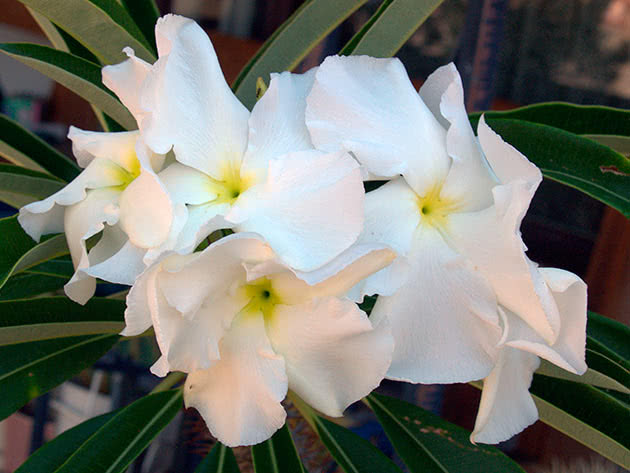

Photo: Pachypodium lamerei
Pachypodium geayi
It is a tree with a thick and thorny trunk, reaching a height of 3 to 6 meters.At a young age, this species is very similar to Lamer's pachypodium, but its leaves are narrower, only 1-3 cm wide, and pubescent. Young spines are light gray in color, but their tips are black. The flowers are white with a yellow center. In indoor culture, the plant reaches a height of 50-60 cm.
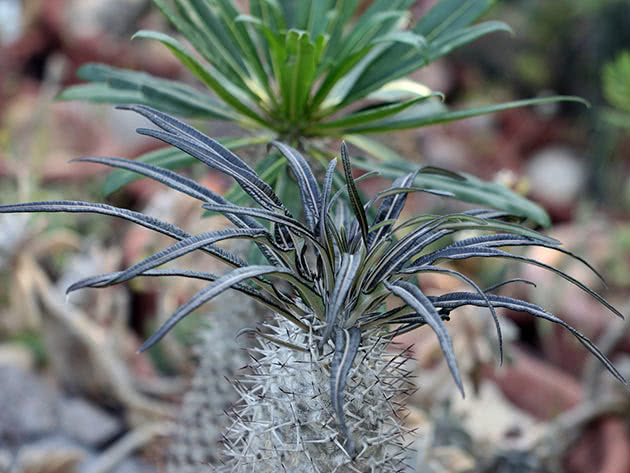

Photo: Pachypodium geayi
Pachypodium short-stemmed (Pachypodium brevicaule)
When there are no leaves on it, it resembles the gray stones surrounding it in nature: the stem of the plant is flat, tuberous, prickly, up to 60 cm high. This species blooms with elongated yellow flowers.
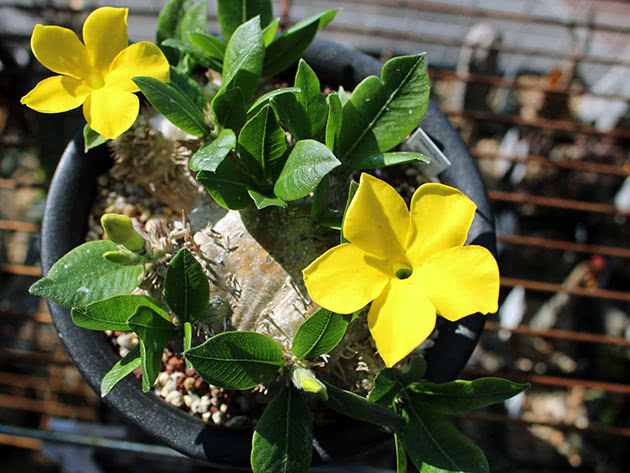

In the photo: Pachypodium brevicaule
Pachypodium saundersii
A succulent with an almost spherical gray-green stem, reaching a height of one and a half meters. The plant is equipped with a few thorns up to 2.5 cm long. Its leaves are broadly lanceolate and pointed at the ends. The Saunders pachypodium forms many white flowers with a pink stripe on the petals.


Photo: Pachypodium saundersii
Pachypodium succulentum
This is a plant with a turnip root, gradually turning into a thickened tuber with a diameter of up to 15 cm, which, higher, becomes a woody stem with age, fleshy and branched, reaching a height of 60 to 90 cm.On young branches, there are paired spines 1-2 cm long and slightly pubescent lanceolate leaves up to 5 cm long and up to 1 wide. In summer, bell-shaped pinkish flowers with a red throat, reaching 4 cm in diameter, open on the plant.
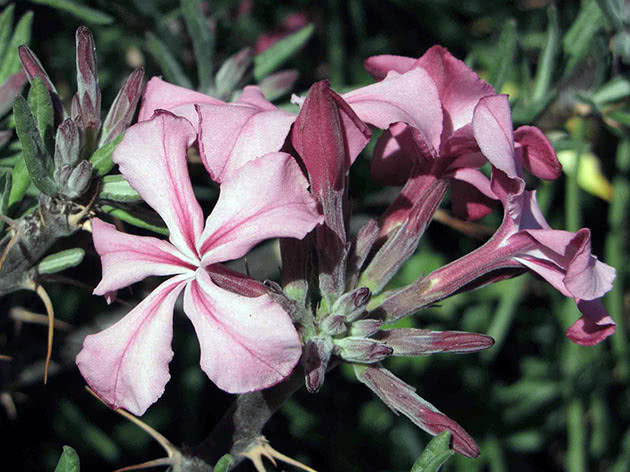

In the photo: Pachypodium succulentum
Pachypodium densiflorum
It is a slow growing succulent shrub up to 45 cm tall. It has a fleshy prickly gray-green trunk up to 30 cm in diameter, decorated with a rosette of leaves at the top, green on the upper side and gray tomentose below. The flowers of this pachypodium are up to 3 cm in diameter, bright yellow, tubular, with a widened end and yellow anthers forming a cone.
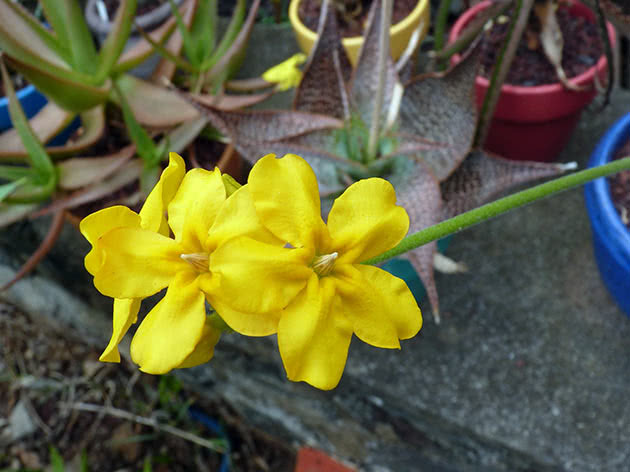

In the photo: Pachypodium densiflorum
Pachypodium horombense
A short succulent with a wide, smooth and thickened silvery-green trunk at the base and small, narrow gray-green leaves forming a rosette at the ends of the branches. Large yellow flowers of the plant are located on long pedicels.
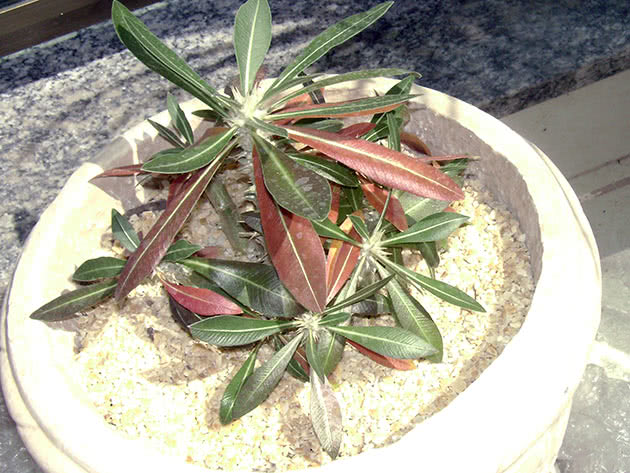

Photo: Pachypodium horombense
Pachypodium meridionale
Under natural conditions, it can reach 3 m, but in a pot culture its growth is limited to 120 cm.The leaves of this pachypodium are green, long and narrow, the trunk is silvery brown, smooth, up to 60 cm in diameter, and large flowers with pink petals and a reddish corolla have a pleasant smell.
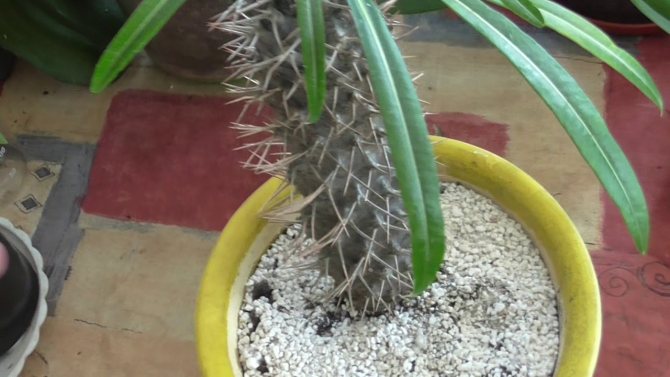

Pachypodium rosette (Pachypodium rosulatum)
It is a fleshy succulent with cylindrical, upright branches and caudex. The trunk of the plant is short, thickened at the base, gray-green. The branches are densely covered with thorns. Glossy, leathery, narrowed-oblong green leaves with a light midrib are located at the ends of the branches in whorls or rosettes. Greenish-yellow or yellow tubular flowers are collected in few-flowered racemes on long pedicels.
This plant has a variety:
- graceful (Pachypodium rosulatum var. Gracilius) - shrub 40-60 cm high with gray or light brown caudex, rounded and slightly compressed laterally, smooth or covered with dense spines. The branches of the plant are short, winding, sometimes smooth, sometimes thorny. The leaves are collected in rosettes on the horses of the branches. The flowers are tubular with a widened end, bright yellow, gathered in groups on long pedicels.
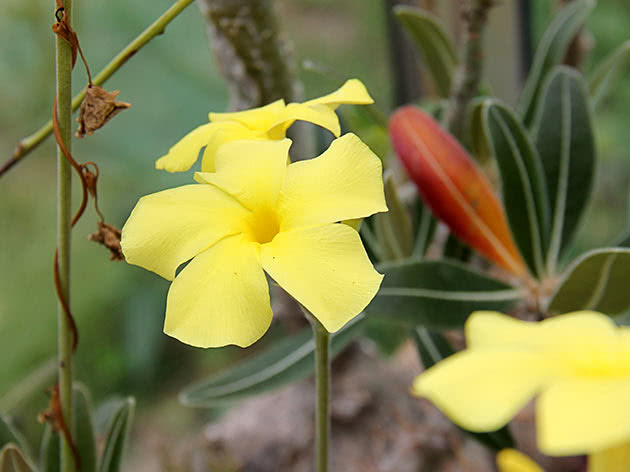

In the photo: Pachypodium rosette (Pachypodium rosulatum)
Feature and Description
Pachypodium or in Latin Pachypodium comes from the Kutrovy family and is a perennial succulent in the form of a tree or shrub. He came to indoor culture from the hot places of Australia, southern Africa and Madagascar. Among the people, this succulent even received a nickname "Madagascar palm", although it has nothing to do with palm trees.Only its appearance in adulthood, when a tall, thorny stem is crowned with a bunch of long leaves, gives the impression of a resemblance to this tropical tree. The Latin name of the plant comes from the phrase "thick leg", which indicates the impressive size of the stem.
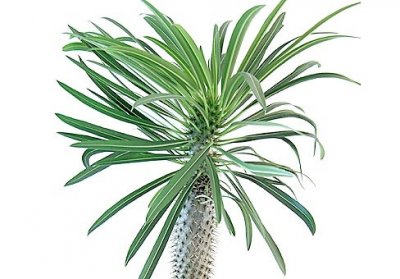

In nature, a slow-growing pachypodium sometimes grows up to 10 m, while indoors - up to 30 cm (maximum for some species) or up to 1.5 m. 15 years or more depending on the conditions of detention.
Some flora lovers notice the resemblance to milkweed in the pachypodium, and this is no coincidence. Plant too poisonous and dangerous however, its juice does not burn the skin. Still, it is better to avoid contact with milky juice, very carefully transplant the tree and place it away from children and animals so that they do not get hurt by sharp thorns.
The leaves of the "Madagascar palm" are simple and whole and grow from the very top of the trunk. The stem of the tree is very thick, fleshy and covered with sharp thorns. The flowers collected in a brush are snow-white, rather large and have a graceful tubular shape. They open up and delight the grower with their beauty mainly during the day.
Popular varieties
In indoor culture, there are different types of pachypodiums. Five varieties are especially popular.
- Pachypodium Lamer. A large variety of the pachypodium. In an apartment it grows up to two meters, in nature - up to six. The barrel is cigar-shaped, silvery-gray. Little or no branching. Young specimens are abundantly covered with long needle-shaped spines, which are localized in the axils of the leaves, three pieces are collected. With age, the plant sheds old leaves, while thorns remain on the stem. Leaves are oval elongated, flowers are small, fragrant, white.
- Pachypodium of Jaya. Quite a large tree. The trunk is thick, abundantly covered with thorns. Lamer differs from pachypodium in narrowed pubescent leaves. The flowers are white, the core is yellow. In apartments, it does not grow more than 60 cm.
- Pachypodium Sanders. The main stem is shortened and has the shape of a cylinder. At the top of the head, it begins to branch, forms several twisted shoots. The spines on the stems are long, brown in color. Ovate dark green leaves form small rosettes at the ends of the stems.
- The pachypodium is short-stemmed. Miniature variety. The stem is tuberous, without a definite shape. An adult specimen grows no more than 10 cm, but its width can reach 40 cm. It gives many shoots in the form of small tubercles. Rosettes of small leaves are located on them. The thorns are soft, conical. Flowers are larger than leaves, yellow in color.
- The pachypodium is succulent. A shrub that is quite large for indoor culture. The main trunk is repiform, wide. Branching is intense, concentrated at the top. Shoots are thin, leaves are slightly pubescent, narrow. Thorns are thin, not very long, growing in two.
With good care, flowering can be achieved from the pachypodium Lamer. Only adult plants at least seven years old bloom.
How pachypodium reproduces
It is best to purchase a ready-made plant at a flower shop, but if you wish, you can try to propagate the succulent yourself. For this, seed propagation and cuttings are used. Both options are clear and accessible.
Seeds
Most often, the pachypodium is grown from seed. This method is more practical than cuttings.
Its advantage is that a larger number of seedlings take root. But there is also a minus - the process of emergence of an adult plant from seeds is very long, it takes several years.
The seed germination process is quite high, so you can safely take this method.
By cuttings
Propagation by cuttings is not very rational, most cuttings rot and die.
To carry out the procedure, they take a scrap of the upper part of the succulent 15 cm long, cut off with a very sharp, well-disinfected knife and plant it in a standard soil mixture.
Pachypodium. Leaving, dormant period, reproduction at home.
Pachypodium (Pachypodium) - genus succulent plants families Kutrovye (Apocynaceae).
The name of the genus comes from the Greek language "παχύ" - "thick" and "ποδιυμ" - "leg"), which characterizes the peculiarity of these plants - thick trunks, which accumulate moisture in case of drought. For this purpose, some pachypodiums even developed underground thickened trunks, caudexes. The stem of these plants is covered with thorns, which serve to extract moisture from fog and dew. All these are adaptive mechanisms that have developed in these plants to dry habitat conditions. Indeed, in nature they grow in Africa (Angola, Mozambique, Zimbabwe, Namibia, South Africa, Swaziland), where the temperature ranges from 35 ° C to 45 ° C.
The sizes of the pachypodiums are varied, they can be not only completely dwarf, but also 8 meters high. In indoor conditions, this king of the desert can easily reach 2 meters.
Rest period for pachypodium
At home, this plant does not have a dormant period, therefore, under favorable conditions in the apartment, it can also not be arranged. But in our climatic conditions, most often the pachypodium has a forced dormant period, this is mainly due to insufficiently long daylight hours and lighting intensity, lower temperatures.
During the dormant period, this succulent slows down growth, so it needs to be watered less and kept on a south-facing window.
About pachypodium care at home
Temperature: In summer, the pachypodium feels normal in the temperature range of 18-28 ° C. It can be taken out into the fresh air, which has a beneficial effect on its growth and development. In winter, the temperature must be lowered to 16-18 ° C.
Lighting: A succulent plant needs bright, intense lighting from a south window. Direct sunlight does not harm him at all, so you should not shade it. The pachypodium can also grow normally on windows with a southwest and southeast orientation.
Watering: In summer, the plant needs regular, moderate watering, the potted substrate should be constantly slightly damp. Watering is carried out with soft, settled water immediately after the top layer of the substrate dries out to a depth of 1 cm. At elevated temperatures, watering should be abundant. In winter, watering should be reduced, watered less frequently, and more sparingly. If the pachypodium is young and still has a short stem, watering should be scarce all year round.
Air humidity: It does not need high humidity, but from time to time the pachypodium must be sprayed and showering with warm water for hygienic purposes.
Crown formation and flowering: The pachypodium does not need to be shaped. The first flowering of a succulent can occur at 6-7 years of age, but only with proper care and if the plant is grown in favorable conditions.
Fertilizers: Fertilization begins with the beginning of active growth, when the plant has the first young leaves, usually in the middle of March, maybe even earlier. The pachypodium is fertilized with special fertilizers for cacti once a month into an already watered substrate. Stop applying fertilizers at the beginning of the dormant period, in the fall.
The soil: The succulent plant is not particularly picky in the soil, you should not give preference to the substrate for cacti and succulents, as it has the necessary qualities for growing a healthy plant.
Transfer: Young specimens are transplanted annually, older ones once every 3 years. If necessary, the upper layer of the substrate is changed for adult pachypodiums. The plant is transplanted by the transfer method
Pests: If not properly cared for, the plant can settle spider mites, scale insects, thrips.
Reproduction of the pachypodium at home
At home, the pachypodium is most often propagated by cuttings. This method of obtaining a new specimen cannot be called easy, since the cuttings take root with difficulty, but seed propagation is not so popular, since a plant obtained from seeds develops very slowly. Plus, it is not realistic to get seeds at home, and purchased ones most often do not have sufficient quality.
Before planting, the cutting is dried well, the cut is sprinkled with activated carbon and rooted in the soil for cacti. The container with the handle is placed in a well-lit place.
You can save the dying pachypodium by re-rooting the top of the plant. It is cut off with a sharp knife, dried, sprinkled with activated carbon and also planted in the soil for cacti. Rooting takes place in bright, diffused lighting.
Correct feeding of the pachypodium
In order for the pachypodium to be a strong and beautiful plant, it is necessary to provide it with proper care. It consists not only in watering or feeding, but also in creating good conditions for its growth. These include competent lighting, therefore, the recommendations of experienced florists are taken into account:
- for rapid growth, the flower needs good lighting, so if the pachypodium is grown at home, then it is advisable to install the pot with it on the windowsill or in another place that will receive a lot of sunlight throughout the day;
- it is allowed to grow it in a darkened room, but growth will be slow, and its appearance will not be too attractive, and the pachypodium will be strongly stretched, so its decorative qualities are lost;
- if a window sill is chosen to install the pot, then it is desirable that it be on the south side;
- in the summer, when the weather is warm outside, it is advisable to take the pot outside so that the pachypodium warms up well under the sun, receives a lot of oxygen and ventilates.
Note! In winter, it is almost impossible to provide the pachypodium with an optimal amount of light. In this case, in the spring, it is necessary to take it out into the sun not immediately, but gradually, since the plant has a high sensitivity to a sharp change in lighting, therefore, after a long stay in a darkened place, it cannot be exposed to the sun for a long time, since there is a high probability that burns will appear on the leaves. ...


Pachypodium rosulatum var. gracilis
In nature, the pachypodium is found in places where the soil is deprived of various nutrients or vitamins, therefore, when applying fertilizers, one must be careful, since their wrong choice or excessive use can be detrimental to the pachypodium. When applying dressings, the following tips are taken into account:
- fertilizers are applied no more often than once every two months, and special liquid solutions are used for cacti;
- you cannot purchase fertilizers containing nitrogen, as it can lead to bad consequences for the plant;
- it is not allowed to make top dressing in winter.
If you overdo it with different fertilizers, then this will lead to the loss of the decorative properties of the pachypodium.
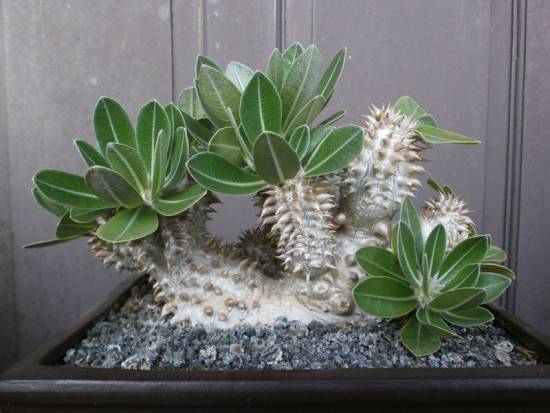

Pachypodium densiflorum
The plant loves bright sun and tolerates heat without any problems. It will feel great on the southern windowsill. Growing in partial shade is also allowed, but then its decorative effect will be lower.
In summer, if there is such an opportunity, it is better to take the pachypodium to the balcony or garden. After winter, since at this time of the year there is no way to provide the plant with the necessary amount of light, you should gradually accustom the succulent to the sun.
Pests and methods of dealing with them
Pests often attack the pachypodium. The most common insects are spider mites, mealybugs, and scale insects. Signs of damage and methods of pest control are described in the table.
Table - The main pests of the pachypodium
| Insect | How to recognize | Measures |
| Spider mite | - Light points on the surface of the leaves; - drying and falling of leaves; - thin cobweb on the underside of the leaves | - Increase in air humidity; - spraying with "Aktara" |
| Shield | - Brown plaques on stems and leaves; - wilting of the pachypodium; - the appearance of sticky drops | - Mechanical removal of insects; - rubbing the affected areas with alcohol; - spraying with preparations "Inta-Vir", "Actellik" |
| Mealybug | - A whitish waxy coating appears in the axils of the leaves of the pachypodium; - growth retardation; - sugary discharge with the addition of a sooty fungus | - Cleaning from plaque with a soft brush dipped in soapy water; - spraying with any insecticide - Mospilan, Confidor, Fitoverm |
Knowing how to care for the pachypodium and understanding what conditions the plant needs, it is possible to grow a large “palm”. The pachypodium looks good in any room, but remember that it is poisonous. You can see more photos on the Internet.
An important stage: transplant
Growing a pachypodium in a pot at home is complicated by the need to transplant it. Sharp thorns and vulnerable roots make this difficult. Slow growth allows for a transplant every two to four years.
Transplanted in the spring, immediately after wintering. The capacity is taken a little more than the previous one, a third of the pot is filled with drainage. Expanded clay, pebbles, broken brick will do. Some people use aquarium soil. Before use, the soil mixture is calcined in the oven or in a pan, poured with a solution of potassium permanganate.
To protect the hands, thick gloves are used; the trunk of the pachypodium is wrapped in a thick cloth. The roots are not freed from the old soil - the plant is rearranged into a container along with a lump of earth.
Pachypodium does not like to be disturbed. But if you know how to care for the pachypodium after transplantation, then it will normally adapt to the new capacity. For a while, the flower needs to be given rest - do not rearrange, do not touch it unnecessarily. Water very gently, only to maintain light soil moisture. There is no need to feed the first month, but you can use "Epin" for a quick recovery.
To protect yourself from unnecessary injuries, you can slightly file down the thorns of the pachypodium. The plant will not suffer from this, and the thorns will become less sharp.

